Rules to Better Branding
Do you have a great company logo?
<introEmbed body={<> Think about McDonalds and you will see the yellow arches, in the shape of an "M". Think of Nike and the swoosh is the first image in your mind. It doesn't have to take millions of dollars and 15 marketing consultancies to come up with a great logo, but make sure you get a professional designer to make it. </>} />The characteristics you should be after:
- Simple - Follow solid basic design principles, such as proportion and symmetry, coherent fonts and matching colors
- Versatile - Your logo will eventually end up on different mediums, and it must work well in all kinds of situations
- Relevant - Represent the company
- Memorable - Be unique
If you follow these principles, people should be able to look at your logo from a distance and know which company it's from. The best trademarks end up cemented into the minds of individuals worldwide.
Some examples of great logos:
- Twitter - the small flying blue bird makes an instinctive correlation to tweeting
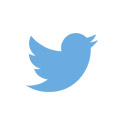
- Mini - the mini "wings" logo is simple and easily recognizable
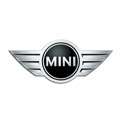
- Canon - the font of the logo simple and is tweaked with only a slight tilt
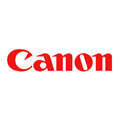
It is very important to remember that your logo should be consistently displayed wherever your company promotes itself.
Do you know branding is more than a logo?
<introEmbed body={<> Many organizations rely too heavily on their logo, assuming it defines their brand. But a brand is much more than a visual mark—it's an emotional connection built through every interaction customers have with your business. </>} />The essence of brand identity
A brand is the sum of customer experiences. As branding expert Marty Neumeier puts it:
"A brand is a result; it’s a customer’s gut feeling about a product, service, or company. It’s not what we say it is—it’s what they say it is."
Branding encompasses much more than just a logo; it includes the color palette, typography, brand elements, visual language, and the brand's voice. It is the consistent application of these elements that truly defines a brand's identity.
<blockquote class="instagram-media" data-instgrm-permalink="https://www.instagram.com/reel/Czqgx2ZSjDG/?utm_source=ig_embed&utm_campaign=loading" data-instgrm-version="14" style=" background:#FFF; border:0; border-radius:3px; box-shadow:0 0 1px 0 rgba(0,0,0,0.5),0 1px 10px 0 rgba(0,0,0,0.15); margin: 1px; max-width:540px; min-width:326px; padding:0; width:99.375%; width:-webkit-calc(100% - 2px); width:calc(100% - 2px);"><div style="padding:16px;"> <a href="https://www.instagram.com/reel/Czqgx2ZSjDG/?utm_source=ig_embed&utm_campaign=loading" style=" background:#FFFFFF; line-height:0; padding:0 0; text-align:center; text-decoration:none; width:100%;" target="_blank"> <div style=" display: flex; flex-direction: row; align-items: center;"> <div style="background-color: #F4F4F4; border-radius: 50%; flex-grow: 0; height: 40px; margin-right: 14px; width: 40px;" /> <div style="display: flex; flex-direction: column; flex-grow: 1; justify-content: center;"> <div style=" background-color: #F4F4F4; border-radius: 4px; flex-grow: 0; height: 14px; margin-bottom: 6px; width: 100px;" /> <div style=" background-color: #F4F4F4; border-radius: 4px; flex-grow: 0; height: 14px; width: 60px;" /></div></div><div style="padding: 19% 0;" /> <div style="display:block; height:50px; margin:0 auto 12px; width:50px;"><svg width="50px" height="50px" viewBox="0 0 60 60" version="1.1" xmlns="https://www.w3.org/2000/svg" xmlns:xlink="https://www.w3.org/1999/xlink"><g stroke="none" stroke-width="1" fill="none" fill-rule="evenodd"><g transform="translate(-511.000000, -20.000000)" fill="#000000"><g><path d="M556.869,30.41 C554.814,30.41 553.148,32.076 553.148,34.131 C553.148,36.186 554.814,37.852 556.869,37.852 C558.924,37.852 560.59,36.186 560.59,34.131 C560.59,32.076 558.924,30.41 556.869,30.41 M541,60.657 C535.114,60.657 530.342,55.887 530.342,50 C530.342,44.114 535.114,39.342 541,39.342 C546.887,39.342 551.658,44.114 551.658,50 C551.658,55.887 546.887,60.657 541,60.657 M541,33.886 C532.1,33.886 524.886,41.1 524.886,50 C524.886,58.899 532.1,66.113 541,66.113 C549.9,66.113 557.115,58.899 557.115,50 C557.115,41.1 549.9,33.886 541,33.886 M565.378,62.101 C565.244,65.022 564.756,66.606 564.346,67.663 C563.803,69.06 563.154,70.057 562.106,71.106 C561.058,72.155 560.06,72.803 558.662,73.347 C557.607,73.757 556.021,74.244 553.102,74.378 C549.944,74.521 548.997,74.552 541,74.552 C533.003,74.552 532.056,74.521 528.898,74.378 C525.979,74.244 524.393,73.757 523.338,73.347 C521.94,72.803 520.942,72.155 519.894,71.106 C518.846,70.057 518.197,69.06 517.654,67.663 C517.244,66.606 516.755,65.022 516.623,62.101 C516.479,58.943 516.448,57.996 516.448,50 C516.448,42.003 516.479,41.056 516.623,37.899 C516.755,34.978 517.244,33.391 517.654,32.338 C518.197,30.938 518.846,29.942 519.894,28.894 C520.942,27.846 521.94,27.196 523.338,26.654 C524.393,26.244 525.979,25.756 528.898,25.623 C532.057,25.479 533.004,25.448 541,25.448 C548.997,25.448 549.943,25.479 553.102,25.623 C556.021,25.756 557.607,26.244 558.662,26.654 C560.06,27.196 561.058,27.846 562.106,28.894 C563.154,29.942 563.803,30.938 564.346,32.338 C564.756,33.391 565.244,34.978 565.378,37.899 C565.522,41.056 565.552,42.003 565.552,50 C565.552,57.996 565.522,58.943 565.378,62.101 M570.82,37.631 C570.674,34.438 570.167,32.258 569.425,30.349 C568.659,28.377 567.633,26.702 565.965,25.035 C564.297,23.368 562.623,22.342 560.652,21.575 C558.743,20.834 556.562,20.326 553.369,20.18 C550.169,20.033 549.148,20 541,20 C532.853,20 531.831,20.033 528.631,20.18 C525.438,20.326 523.257,20.834 521.349,21.575 C519.376,22.342 517.703,23.368 516.035,25.035 C514.368,26.702 513.342,28.377 512.574,30.349 C511.834,32.258 511.326,34.438 511.181,37.631 C511.035,40.831 511,41.851 511,50 C511,58.147 511.035,59.17 511.181,62.369 C511.326,65.562 511.834,67.743 512.574,69.651 C513.342,71.625 514.368,73.296 516.035,74.965 C517.703,76.634 519.376,77.658 521.349,78.425 C523.257,79.167 525.438,79.673 528.631,79.82 C531.831,79.965 532.853,80.001 541,80.001 C549.148,80.001 550.169,79.965 553.369,79.82 C556.562,79.673 558.743,79.167 560.652,78.425 C562.623,77.658 564.297,76.634 565.965,74.965 C567.633,73.296 568.659,71.625 569.425,69.651 C570.167,67.743 570.674,65.562 570.82,62.369 C570.966,59.17 571,58.147 571,50 C571,41.851 570.966,40.831 570.82,37.631" /></g></g></g></svg></div><div style="padding-top: 8px;"> <div style=" color:#3897f0; font-family:Arial,sans-serif; font-size:14px; font-style:normal; font-weight:550; line-height:18px;">View this post on Instagram</div></div><div style="padding: 12.5% 0;" /> <div style="display: flex; flex-direction: row; margin-bottom: 14px; align-items: center;"><div> <div style="background-color: #F4F4F4; border-radius: 50%; height: 12.5px; width: 12.5px; transform: translateX(0px) translateY(7px);" /> <div style="background-color: #F4F4F4; height: 12.5px; transform: rotate(-45deg) translateX(3px) translateY(1px); width: 12.5px; flex-grow: 0; margin-right: 14px; margin-left: 2px;" /> <div style="background-color: #F4F4F4; border-radius: 50%; height: 12.5px; width: 12.5px; transform: translateX(9px) translateY(-18px);" /></div><div style="margin-left: 8px;"> <div style=" background-color: #F4F4F4; border-radius: 50%; flex-grow: 0; height: 20px; width: 20px;" /> <div style=" width: 0; height: 0; border-top: 2px solid transparent; border-left: 6px solid #f4f4f4; border-bottom: 2px solid transparent; transform: translateX(16px) translateY(-4px) rotate(30deg)" /></div><div style="margin-left: auto;"> <div style=" width: 0px; border-top: 8px solid #F4F4F4; border-right: 8px solid transparent; transform: translateY(16px);" /> <div style=" background-color: #F4F4F4; flex-grow: 0; height: 12px; width: 16px; transform: translateY(-4px);" /> <div style=" width: 0; height: 0; border-top: 8px solid #F4F4F4; border-left: 8px solid transparent; transform: translateY(-4px) translateX(8px);" /></div></div> <div style="display: flex; flex-direction: column; flex-grow: 1; justify-content: center; margin-bottom: 24px;"> <div style=" background-color: #F4F4F4; border-radius: 4px; flex-grow: 0; height: 14px; margin-bottom: 6px; width: 224px;" /> <div style=" background-color: #F4F4F4; border-radius: 4px; flex-grow: 0; height: 14px; width: 144px;" /></div></a><p style=" color:#c9c8cd; font-family:Arial,sans-serif; font-size:14px; line-height:17px; margin-bottom:0; margin-top:8px; overflow:hidden; padding:8px 0 7px; text-align:center; text-overflow:ellipsis; white-space:nowrap;"><a href="https://www.instagram.com/reel/Czqgx2ZSjDG/?utm_source=ig_embed&utm_campaign=loading" style=" color:#c9c8cd; font-family:Arial,sans-serif; font-size:14px; font-style:normal; font-weight:normal; line-height:17px; text-decoration:none;" target="_blank">A post shared by Entrepreneur | Business | Motivation (@entreprenur)</a></p></div></blockquote><script async src="//www.instagram.com/embed.js" />Video: Your brand is more than just a logo (40 sec)
Key elements of brand identity
1. Color palette: The emotional trigger
Your brand colors evoke specific emotions. Consistent use helps build recognition and trust. Examples include:
- 🟦 Blue: Trust and stability (e.g., IBM, Visa)
- 🟥 Red: Energy and excitement (e.g., Coca-Cola, Netflix)
- 🟩 Green: Growth and tranquility (e.g., Starbucks, Whole Foods)
2. Typography: Communicating personality
Fonts do more than look good—they communicate your brand’s personality
- Sans-serif fonts (e.g., Helvetica): Modern and approachable
- Serif fonts (e.g., Times New Roman): Traditional and reliable
- Custom fonts (e.g., Coca-Cola’s script): Unique to the brand
3. Tone of voice: Shaping perception
How you say things matters just as much as what you say. Examples of tone in action:
- Formal: Financial institutions (e.g., Goldman Sachs)
- Conversational: Consumer apps (e.g., Slack)
- Inspirational: Athletic brands (e.g., Nike)
Brand guidelines ensure consistency
Without guidelines, brand communication becomes inconsistent. A brand guideline includes:
- Color usage: HEX, RGB values
- Typography standards: Font sizes, spacing
- Logo rules: Placement, acceptable variations
- Imagery guidelines: Photo styles and iconography
- Tone of voice examples: Proper messaging across platforms
Case Study: Google's seamless brand identity
Even without their logo, Google’s identity is recognizable through their playful tone, minimalistic design, and consistent color use. This demonstrates the power of cohesive branding across all touchpoints.
A logo is only the beginning
Your logo may be the face of your brand, but it is not the full story. By aligning all brand elements—colors, typography, messaging, and voice—you build a strong, lasting impression that resonates with customers. Consistency across every interaction fosters trust and makes your brand instantly recognizable.
- Consistency matters: Uniform use of brand elements builds trust
- Create emotional connections: Align brand components with your values to foster relationships
- Use visual identity wisely: Make your visuals reflect your brand’s message
- Evolve over time: Review your brand strategy to keep it relevant
Pro tip: Regularly review your brand guidelines to ensure they evolve with your company’s growth and shifting market demands. For inspiration, explore the IBM Design Language, a comprehensive example of how to maintain consistency across visual identity, tone, and user interactions while adapting to new opportunities.
Do you set design guidelines for your company?
<introEmbed body={<> The start point of your branding is the logo. From there everything the company produces or owns should "feel" like it comes from your company. When you walk by a pile of documents on a desk, you should recognize that it's from your company. It's not just plonking the logo everywhere. These are things to keep in mind for good branding: </>} />- Logo - E.g. SSW Logo
- Web fonts - E.g. At SSW, we use Inter
- Print fonts - E.g. At SSW, we use Helvetica Neue
- Websites - E.g. SSW Web Reference page is an example of good branding instructions for websites
- Newsletters
- Flyers, catalogues, and other promotional material
- Offices façades, and interior decor
- Documents, invoices, and proposals
- Others, like coffee mugs, plastic bags, etc
Tip: Help designers to find stuff in your Intranet
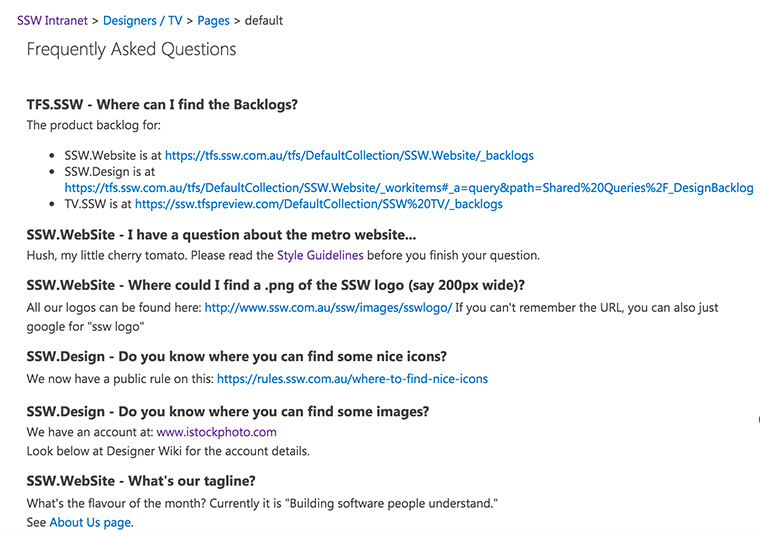
✅ Figure: Good example - Keep things together in your Intranet
Do you keep the same main concept when redesigning a logo?
<introEmbed body={<> It's perfectly normal that a logo starts to look outdated in over decades, so it needs a refresh. In this case, you should aim to keep the most recognizable characteristics of the old logo, so people will automatically know it's the same company when they first see the new logo. <asideEmbed variant="greybox" body={<> **Warning:** Be careful before redesigning - Some brands are constantly changing in order to “stay fresh”, but that’s a mistake. Customers stay loyal through habit, not because you've forced something new and unfamiliar on them. <introYoutube url="https://www.youtube.com/embed/dOIRSqNqAzE" description="Video: Think Twice Before Updating Your Brand (8 min)" /> </>} figureEmbed={{ preset: "default", figure: 'XXX', shouldDisplay: false }} /> </>} />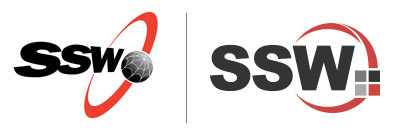
✅ Figure: Good example - Although the SSW logo was completely redesigned, you can easily recognize it's the same company because the logo concept didn't change
Do you use identifying company logo motifs?
<introEmbed body={<> You can still create immediate brand recognition even when it's not applicable to use your full company logo. This can be achieved by taking symbols or motifs out of your main logo and using them in your branding material. </>} />For example, the SSW has 4 little coloured square as motifs within the logo, and these squares can be used without the rest of the logo text.
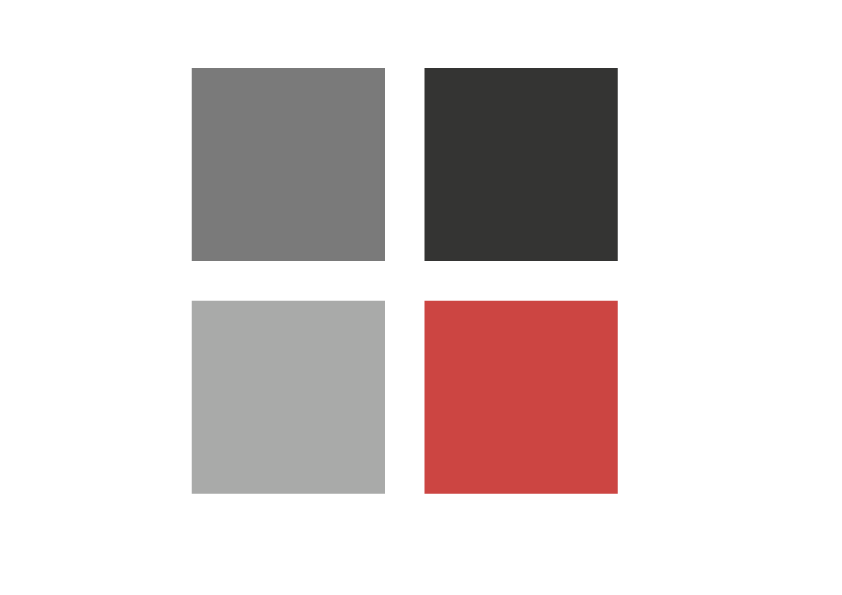
Figure: SSW logo motif
Do you have cool business cards?
<introEmbed body={<> Business cards are essential tools for networking and making a lasting impression on potential clients or business partners. However, traditional paper business cards can present various issues in today's digital age. </>} />This rule introduces the advantages of digital business cards over their paper counterparts, emphasizing the benefits of using the apps as powerful tools for creating and sharing professional and memorable digital business cards.
The limitations of paper business cards
Paper business cards, while widely used in the past, come with several drawbacks in the modern business landscape. Here are some common issues associated with paper business cards:
- Prone to loss or damage: Paper business cards can easily be misplaced, lost, or damaged, making it challenging to maintain accurate contact information
- Environmental impact: The production and disposal of paper business cards contribute to deforestation and waste, which goes against sustainable business practices
- Outdated information: When contact details change, reprinting paper business cards becomes necessary, resulting in additional costs and time
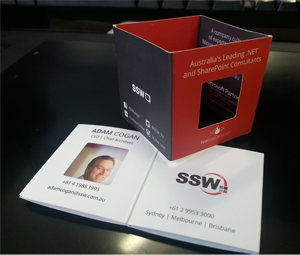
😐 Figure: OK example - If you are going to have paper business cards, make sure they pop!
Embracing digital business cards
In contrast to paper business cards, digital business cards offer numerous advantages that address the limitations mentioned above. Here's why digital business cards are a superior choice:
- Comprehensive information: Digital business cards provide ample space to include all relevant contact details, ensuring recipients have access to a comprehensive profile
- Easy sharing and accessibility: Digital business cards can be easily shared via email, messaging apps, or even through scanning QR codes, making it effortless for recipients to store and retrieve contact information
- Real-time updates: With digital business cards, updates to contact details can be made in real-time, ensuring recipients always have the most accurate and up-to-date information
- Interactive features: Digital business cards often allow for interactive features like clickable links to websites, social media profiles, or portfolios, enhancing engagement and facilitating further connections
- Sustainability: By opting for digital business cards, you contribute to a more sustainable environment by reducing paper waste and promoting eco-friendly practices
Utilizing LinkedIn’s QR code feature
The best way to connect with someone is to use LinkedIn's built-in QR Code feature
Note: This will not share contact details.
Here's a step-by-step guide on how to use it:
- Launch the LinkedIn app on your device
- Tap on the search bar located at the top of the screen
- Look to the right side where you'll find an icon resembling a QR scanner. Tap on this icon
- This will display your unique QR code, allowing others to scan it. Alternatively, you can tap the scan button to scan someone else's QR code
This approach offers an efficient means of leveraging LinkedIn's features, and it's bound to leave a positive impression on anyone you connect with.
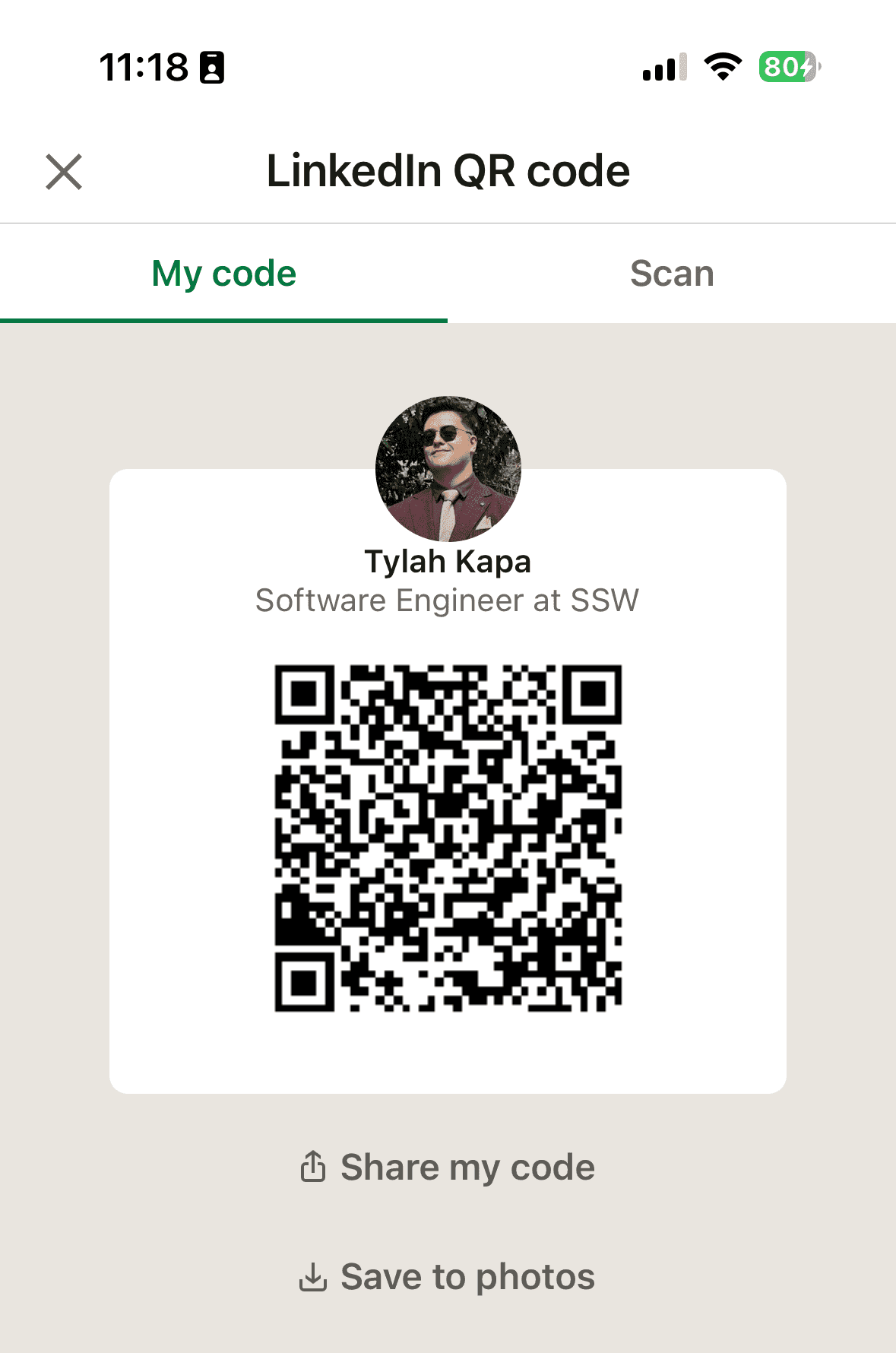
Figure: The easiest way to connect on LinkedIn is to open the QR Code and let others scan it
The HiHello mobile app
Video: How To Send and Receive a HiHello Digital Business Card (50 sec)When it comes to creating and sharing impressive digital business cards, the HiHello app stands out as an excellent tool. Here's why you should consider using the HiHello app:
- Professional and customizable designs: The HiHello app offers a wide range of professional and visually appealing templates for your digital business card. You can customize the design to reflect your personal brand and make a memorable impression
- Versatile contact details: HiHello allows you to include various contact details, including phone numbers, email addresses, social media links, website URLs, and more. You can add multiple options for each contact method, ensuring flexibility and convenience for recipients
- Easy sharing and scanning: HiHello simplifies the process of sharing digital business cards by enabling recipients to receive them via email, text message, or by scanning a QR code. This streamlined sharing process saves time and ensures seamless connectivity
- Real-time updates and syncing: The HiHello app enables you to update your contact details on-the-go. Once updated, your digital business card will automatically sync across all devices of your recipients, ensuring they always have the most accurate information
- Analytics and insights: HiHello provides analytics and insights on how your digital business card is performing, such as the number of views and interactions. This data helps you track engagement and assess the effectiveness of your networking efforts
By leveraging the benefits of digital business cards and utilizing the HiHello app, you can present yourself professionally, enhance networking opportunities, and stay connected with ease.
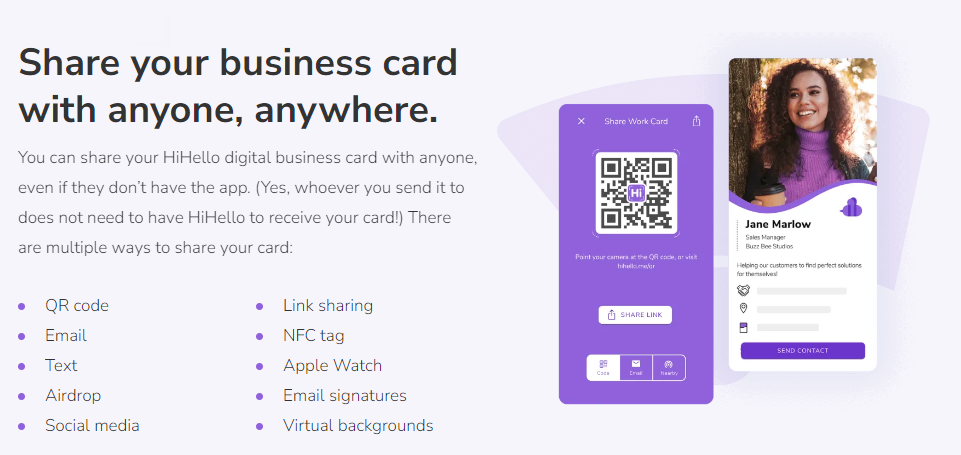
✅ Figure: Good example - Digital business cards such as HiHello are awesome!
Add your digital business card to your phone's wallet
Digital business cards offer a range of advantages over their paper counterparts, and one of the notable benefits is the ability to add them to phone wallets.
Here are the instructions for adding a digital business card to your phone wallet using the HiHello app:
- Download and install the HiHello app: Visit your app store (iOS or Android) and search for "HiHello." Download and install the app on your smartphone
- Create your digital business card: Open the HiHello app and sign up or log in to your account. Follow the prompts to create your digital business card by entering your contact details, choosing a template, and customizing the design to your preference
- Save your digital business card to your phone wallet: Once your digital business card is created, follow these steps to add it to your phone wallet:
- For iPhone users (Apple Wallet):
- Tap the "Share" button located at the top right corner of your digital business card within the HiHello app
- From the sharing options, select "Add to Wallet"
- Your digital business card will be added to the Apple Wallet on your iPhone
- For Android users (Google Pay or Samsung Pay):
- Tap the "Share" button located at the top right corner of your digital business card within the HiHello app
- From the sharing options, select "Save to Gallery" or "Save to Files" to save the digital business card as an image file on your phone
- Open the Google Pay or Samsung Pay app (depending on your device)
- Tap on the "+" or "Add" button to add a new card
- Choose the option to add a "Loyalty card" or "Membership card"
- Follow the prompts to select the saved image of your digital business card from your gallery or files
- Access and share your digital business card: Once your digital business card is saved in your phone wallet, you can easily access it anytime by opening your wallet app. You can then share it with others by tapping on the card and selecting the sharing option provided by your wallet app
Do you use great email signatures?
<introEmbed body={<> Email signatures are a great way of adding some advertising and branding. You should **always use a nice email signature for external emails**. Internally, you may use a short one (just your name or initials). </>} />Full email signatures (for external recipients) are great when they have:
- A little branding and advertising (can be a tagline or company news), so people know instantly who it is from
- You can promote services or awards at the bottom (e.g. "⭐️ 2023 Microsoft Partner of the Year Finalist")
- Your phone number (in international format - it's important to add the country code so people from all around the world can easily add you to their contacts - as per the right format to show phone numbers)
- Your company website link
- Your social media and blog link
- Your IM link (e.g. Teams or Facebook Messenger)
- Your position
- Your location (city/country) where you are based
Note: You can't add hyperlinks to signatures if you are using the Outlook App – what a shame.
Mobile Signature
Use the mobile signature when sending emails from your phone. Mobile signatures are not easily customized so they can be simpler.
Get Outlook for Android
❌ Figure: Bad example - The default signature
Thanks, Adam
ssw.com.au | +61 2 9953 3000 | Ping me on Teams✅ Figure: Good example – Custom signature with name, URL, phone number, and IM link
PC Long Signature (Big and Fancy)
Use the complete long signature when sending a new email or appointment to a client.
This is created in HTML and goes well on emails with Word used as the email editor. Include some product advertising, like what's new on your monthly newsletter. It should have the company colors.

Figure: A great long signature for PC
However, you shouldn't use your long signature on every sent email. It's recommended to have a simpler version for internal emails and appointments:
PC Short Signature
Use a really short signature (your first name or initials) or no signature at all in internal emails as people already know who you are. You may want to add a quick link to IM.

Figure: PC Short Signature Example
Note: "Ping me on Teams" is a link that directly opens chat with the person as per Teams Hyperlinks on Outlook Signature .
Implementation
Option 1: CodeTwo (paid)
The easiest way to implement consistent signatures across a company is to use a 3rd party signature provider e.g. CodeTwo.com and Exclaimer.com
This way you quickly get great email signatures, with consistent branding, to all your employees and on all their devices. CodeTwo is cheaper and has a nicer design tool UI than Exclaimer, however they are both good. CodeTwo is built on Microsoft technology.CodeTwo (and Exclaimer) give:
- Automatic signatures are added on any device – from laptop to smartphones
- Consistent signatures for every employee as they all use one template – consistency is important
- Management via a portal
- Marketing can run campaigns and schedule changes to all signatures
- Hassle-free setup – users do not need to touch any signatures on any devices
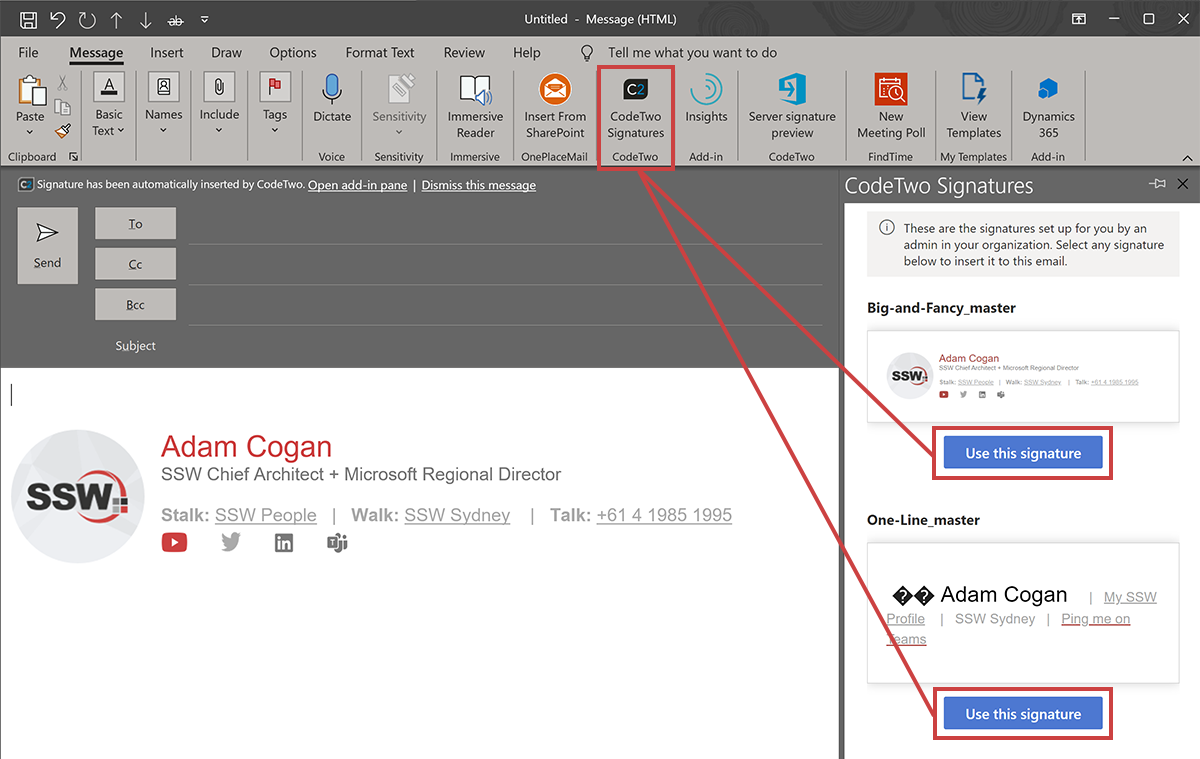
Figure: With CodeTwo the correct signature is auto selected
Note: The plugin currently does not work for Appointments due to a limitation in Outlook. Rules must be manually changed in Exchange Online to include appointments in the server-side version of CodeTwo. Once this has been configured do not manually copy your signature into an appointment or you will get 2 signatures.
Option 2: Set it up manually (free)
Mobile - How to set it up in the Outlook App
- Go to Settings on the Outlook application
- Click on Signature
- Type your desired signature for mobile
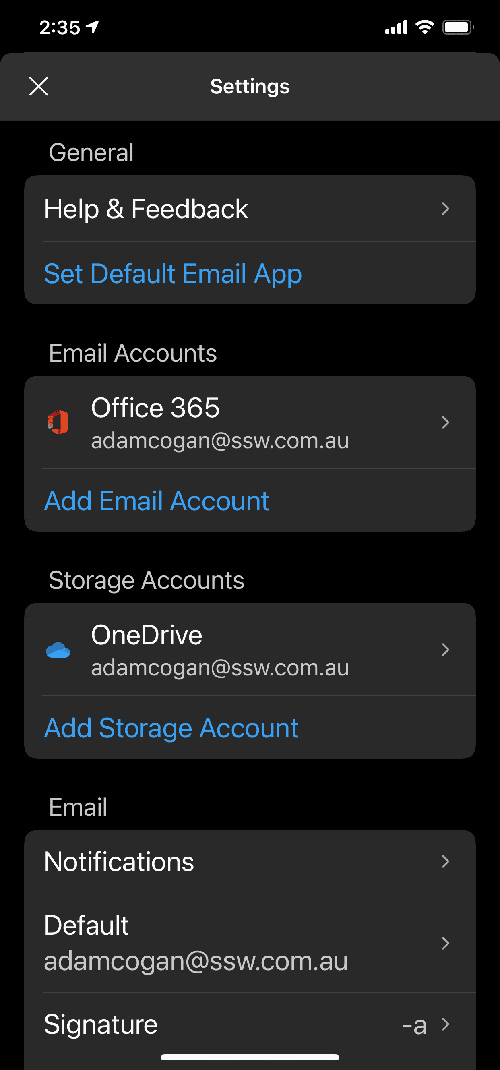
Figure: Outlook mobile application settings
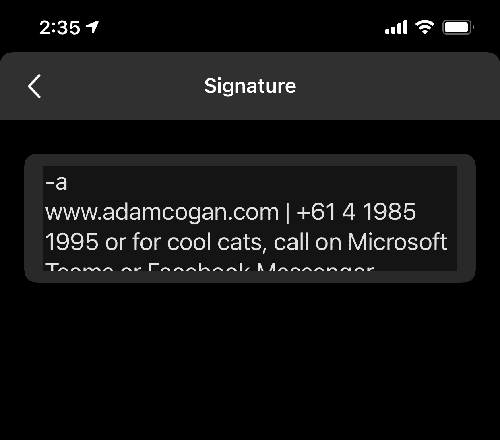
Figure: Editable mobile signature on Outlook mobile application
PC - How to set it up in Outlook
For windows
- Open Microsoft Outlook and go File | Options
- Click the "Mail" tab as seen below
- Click on "Signatures..." and add in your signatures
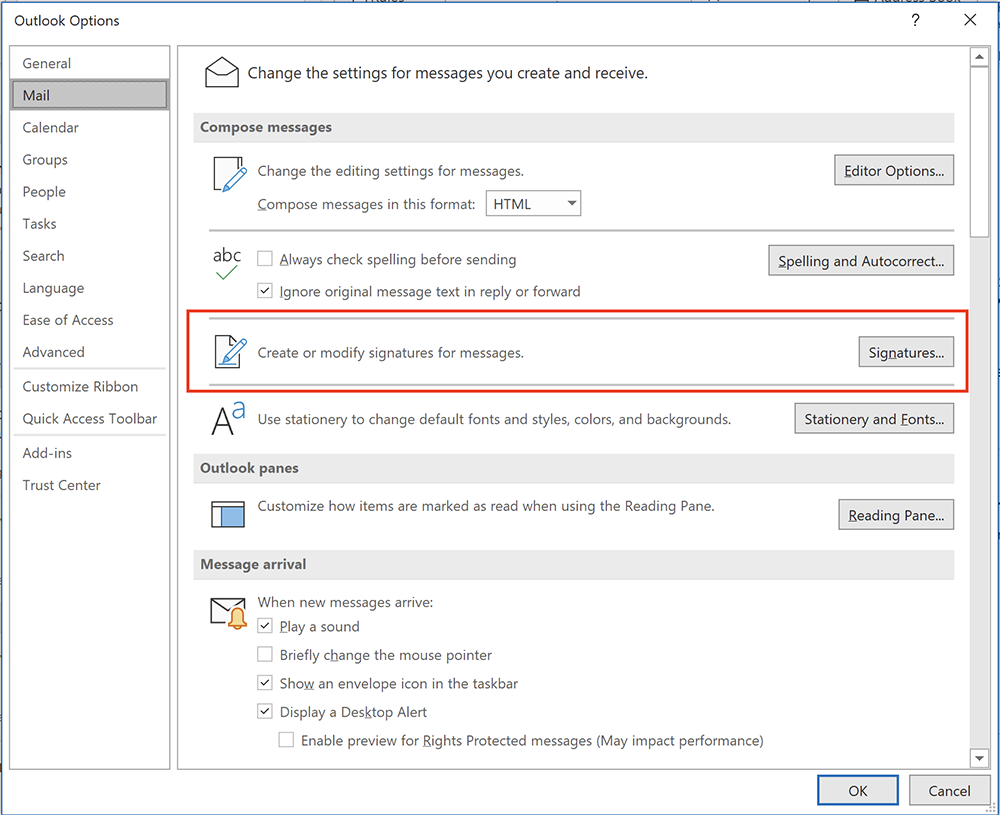
Figure: How to add a signature in Outlook in Windows
For Mac
- Open Microsoft Outlook app and go Outlook | Settings
- Click the "Signatures" tab in the "Email" section
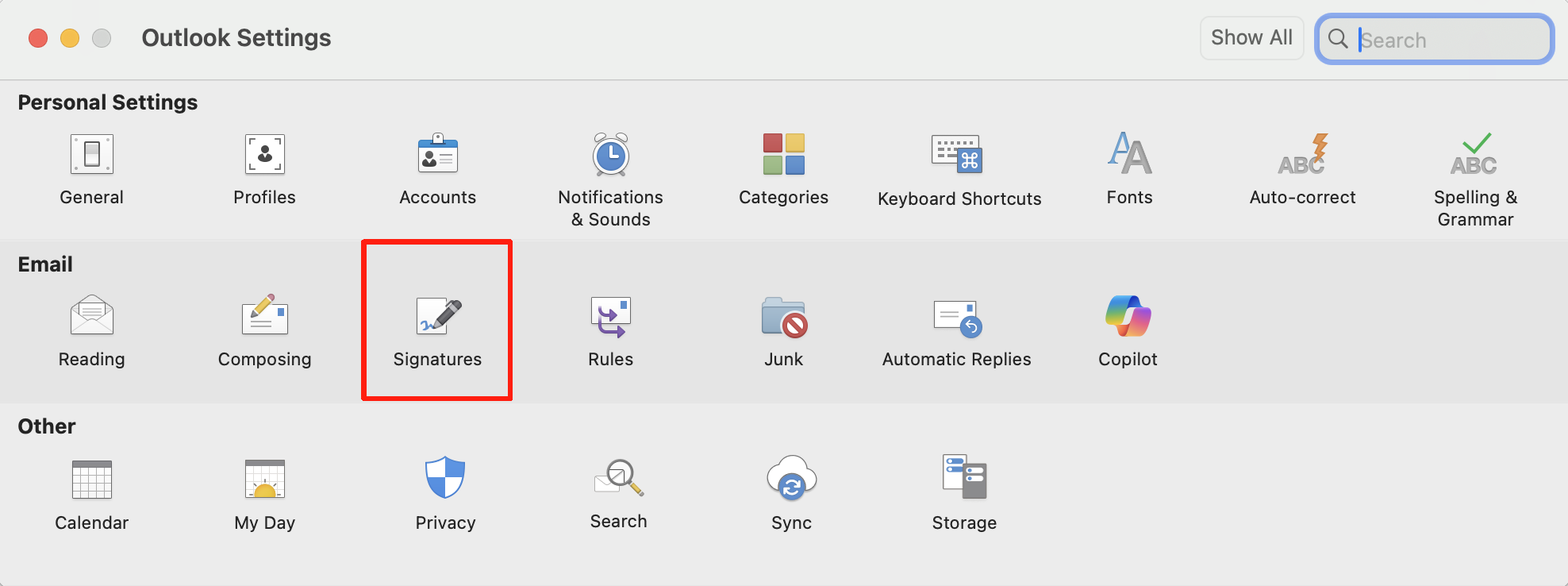
Figure: How to add a signature in Outlook in Mac
Warning: Unfortunately, you need to setup up your signature in Outlook and OWA. There is no way to share this.
Browser - How to set it up in OWA
- Open OWA (e.g. mail.northwind.com/owa)
- Click "Options" on the top right side.
- Go Settings | Mail and make following changes:
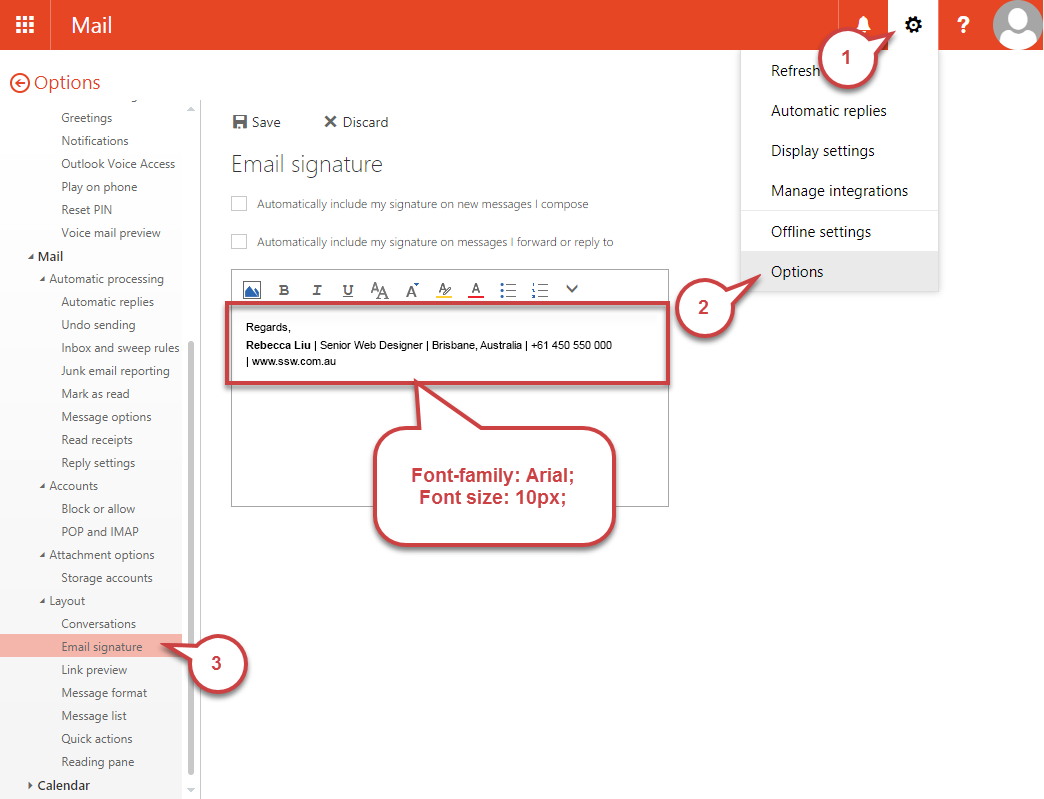
Figure: Add your 'Email Signature' and save
How to set it up in Office 365
- Open Outlook in Office 365 (http://outlook.office.com/mail/inbox)
- Click the "Settings" cog on the top right corner of the Window
- Click on “View all Outlook settings” at the bottom of the Settings panel
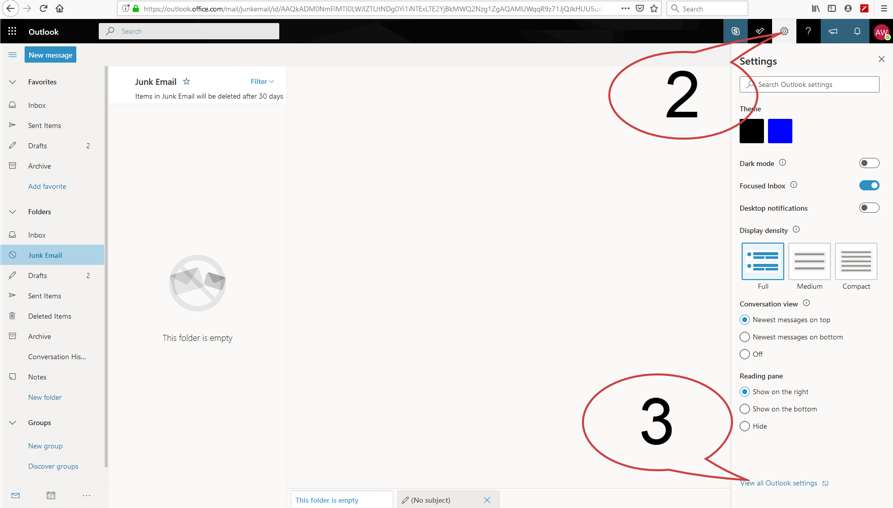
Figure: Where to find "View all Outlook settings"
- In the "Settings" window that pops up, go to: Mail | Compose and reply.
- Add your email signature and click "Save"
SSW Only: You can automatically have your Outlook signature changed on sign-in via SSW login script.
Note: This does not setup your signature on OWA or your mobile signature.
Do you add branding to your browser's new tabs?
<introEmbed body={<> Changing the appearance of your browser's new tabs can greatly enhance your browsing experience and add a touch of personalization. By incorporating branding elements, you can make your browsing sessions more enjoyable and reflective of your unique style. </>} />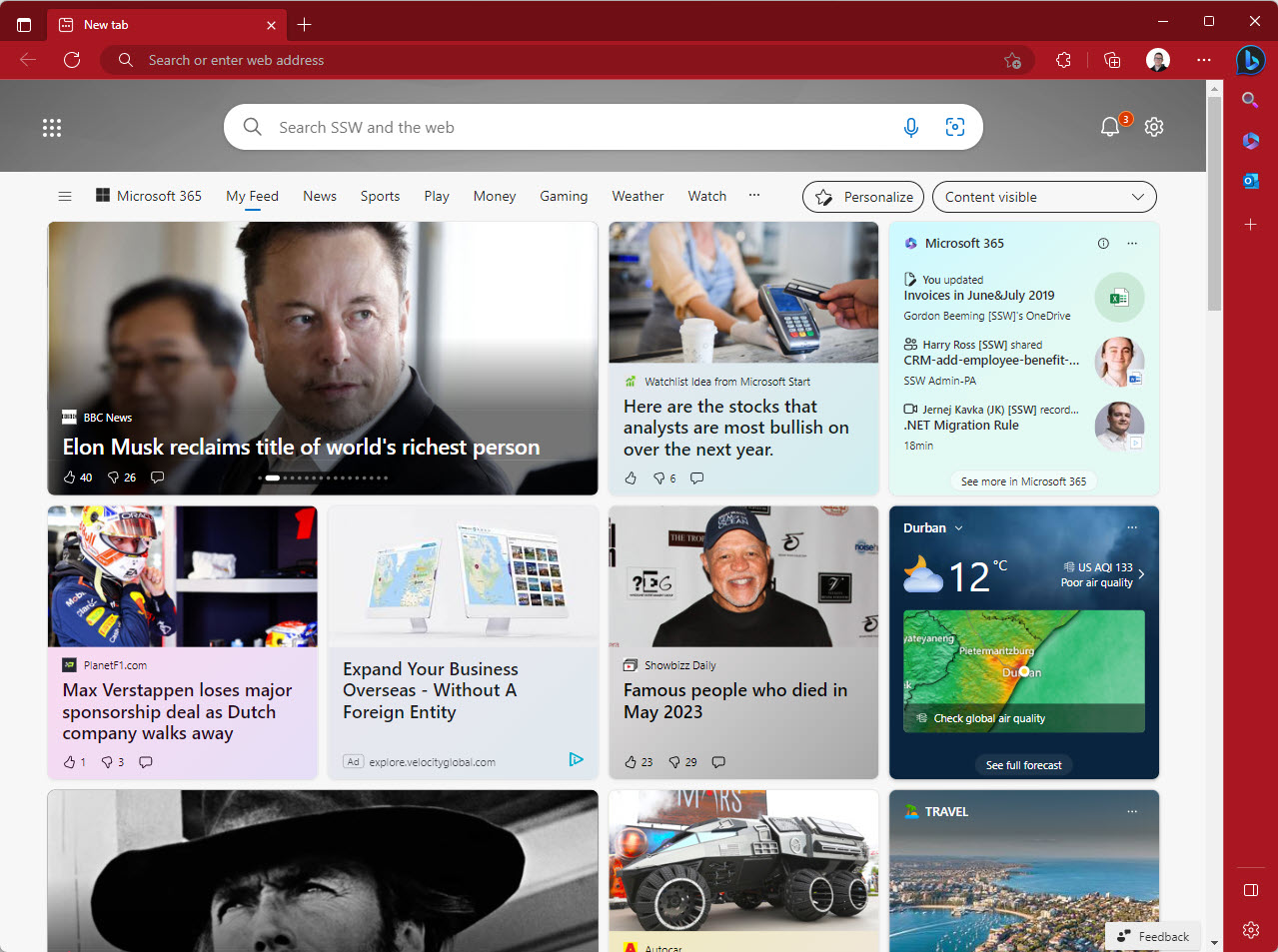
❌ Figure: Bad example - Default new tab
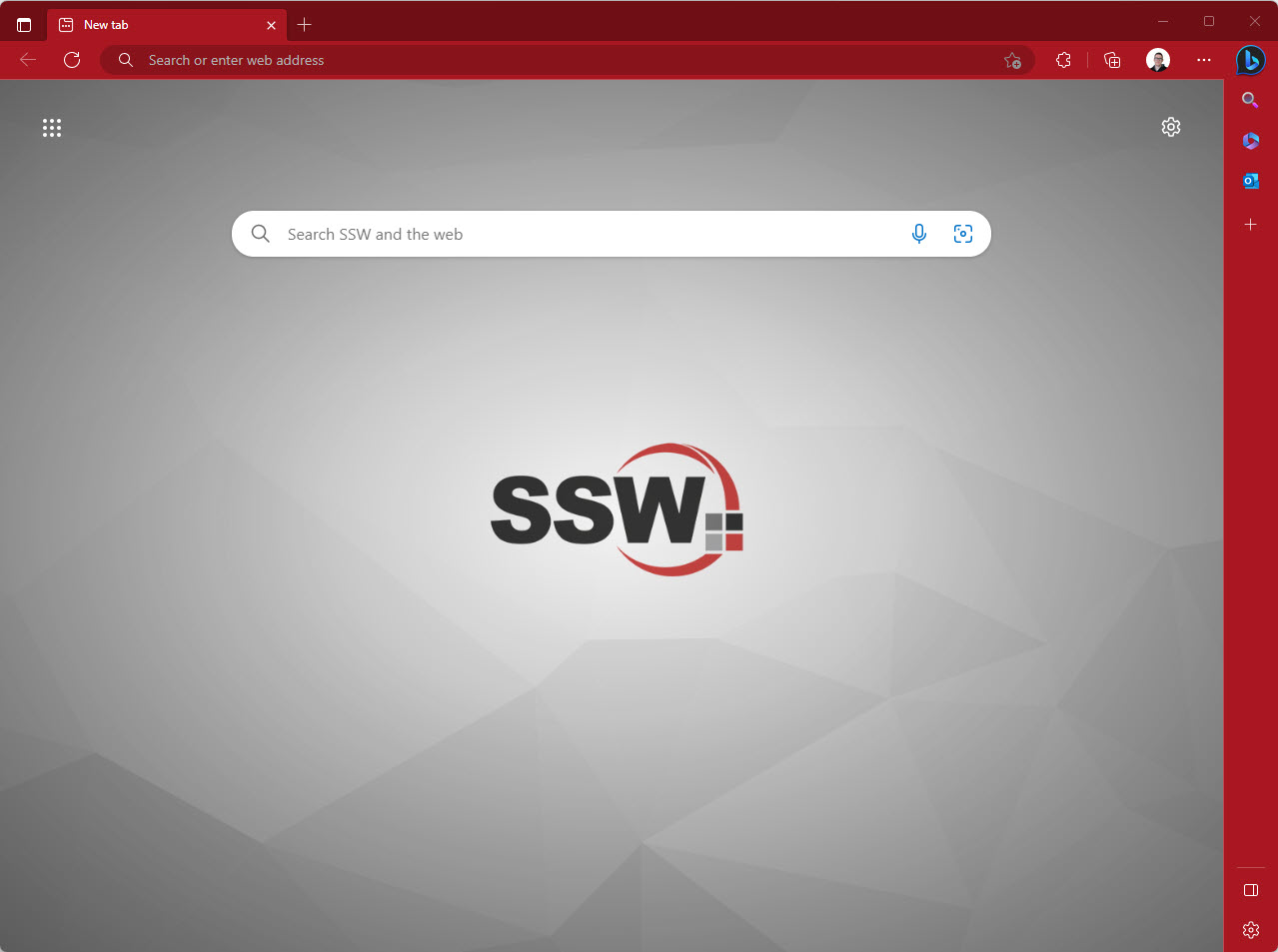
✅ Figure: Good example - Branded new tab
Tip: You can also change your browser theme color to match your branding. This is especially useful to differentiate multiple profiles in your browser.
How to add a branded image to your new tab experience
Setting a different per Edge or Chrome profile background image is a great way to have some branding and quickly identify which profile you are using when opening the browser or a new tab.
- Open your Edge or Chrome browser
- If you are not in the new tab experience click the + button to open a new tab
- Click on settings | Edit Background
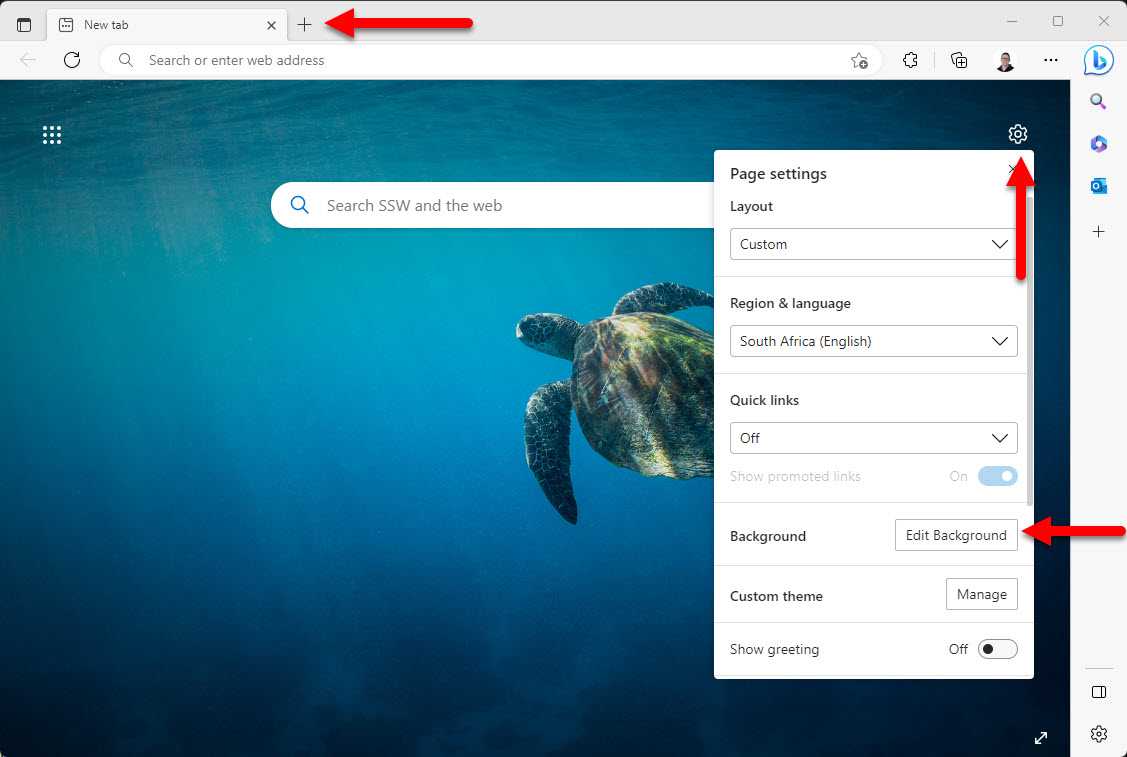
Figure: Opening new tab settings in a Microsoft Edge browser
- Click on "Upload Image", select the image you want to use and click "Open"
- Click "Apply"
- Uncheck "Change new background daily"
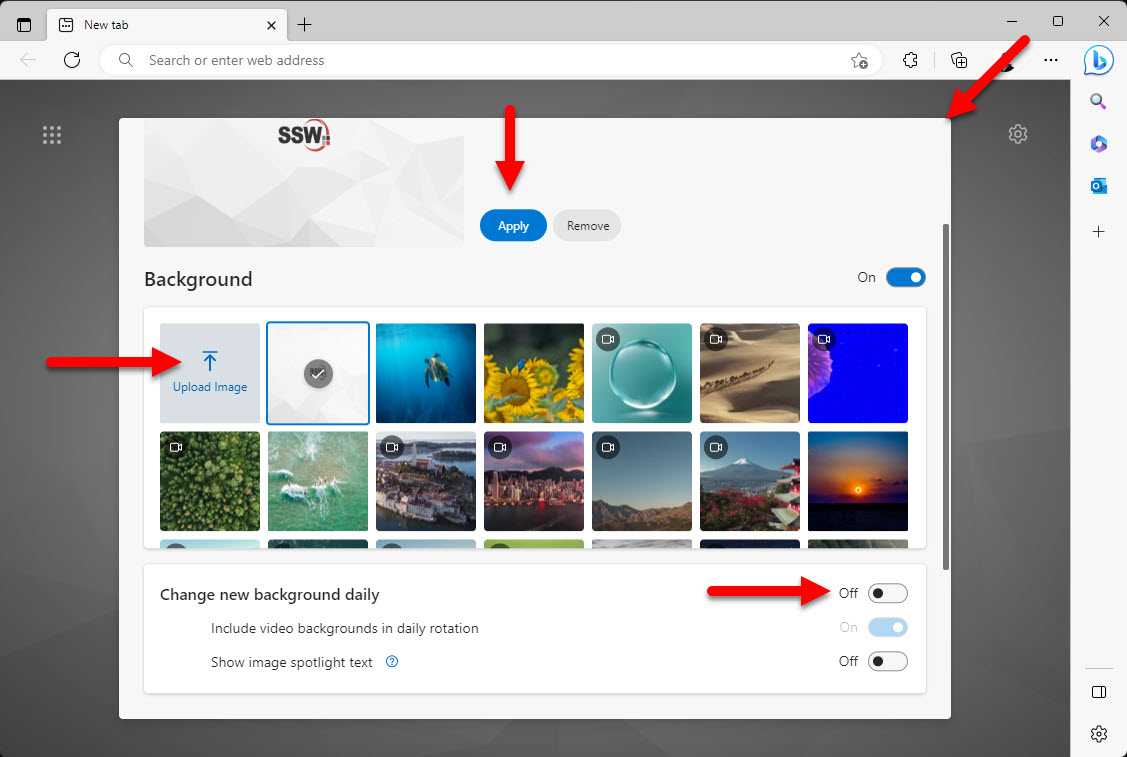
Figure: Where to make changes
- Close the dialog box, note you might have to scroll back up to see the "Close" button
Now every time you open a new tab or the browser you will see your custom background image and immediately know which tab you are in without having to glance over to the small profile image.
Do you brand your products?
<introEmbed body={<> At SSW, after consulting, the second tier of our business are the [software products](https://www.ssw.com.au/ssw/Products/ProdCategoryList.aspx). It should be obvious, as soon as our software is run, which company built the application. And more than just plonking the logo in the corner - the app should be recognizable even if the logo has been taken away. </>} />Here are some of the basics of our software:
- Company logo on footer and credits
- Product logo on top of main screens (the different software and products logos should be consistent with each other)
- Consistent colors and fonts throughout the whole application
The setup and software icon for your applications should also be branded.
If you have many products, keep them consistent.

✅ Figure: Good Example - Consistent product logos
Do you brand your events?
<introEmbed body={<> Think of a sporting event and it's likely that you can think of a sponsor for the event. For example: - **Australian Iron Man Series** - Uncle Toby's - **Formula 1** - Valvoline, Ferrari - **Wimbledon** - Rolex The list goes on... </>} />What this highlights is a company's ability to successfully partner their brand with events that their target market either attend or watch. Though on a much smaller scale, every business should apply this same principle. So we say if you're going to hold any events that are geared towards your target market - like a user group, make sure there's some branding at the event. Here are some examples of how we brand our user group:
- You should have a promotional sign
- Any presentations should use a standard template
- You should use branded plastic bags
- Evaluation forms should have clear branding
When it comes to branding events, you need to remember that it's often the little things that make the biggest difference. That evaluation form or gift bag that you gave out to someone at one of your events could land in the hands of one of your biggest clients in the future, so be diligent and consistent.
Do you brand cars nicely?
<introEmbed body={<> It's a good idea to brand company cars when they're on the road. These cars are essentially moving billboards for the company. </>} />To get more branded cars, you can reward employees to brand their personal cars.
Make sure the cars look nice with the current company logo and tagline!

✅ Figure: Good example - Branded car
Do you brand your employees?
<introEmbed body={<> Your people are a huge part of what makes your company awesome or unique, so you should use this to your advantage by asking them to be your walking spokespersons and/or billboards. Branding your employees is especially important at events such as conferences, user groups and client meetings. A simple way to do this is to wear branded shirts or t-shirts every day. If you wear a collard shirt, your corporate uniform should be simple and stylish - don't forget that your branding can be subtle and effective at the same time. Also remember that uniforms don't have to be boring or uncomfortable, but they do need to represent who you are as a company. If you decided to do something fun, pop culture t-shirts are always a popular choice, particularly at conferences, but you should take great care to make sure that the message aligns with your corporate image. If you nail this, your employees will love to wear your t-shirts to work and out in the general community, adding to your exposure. </>} />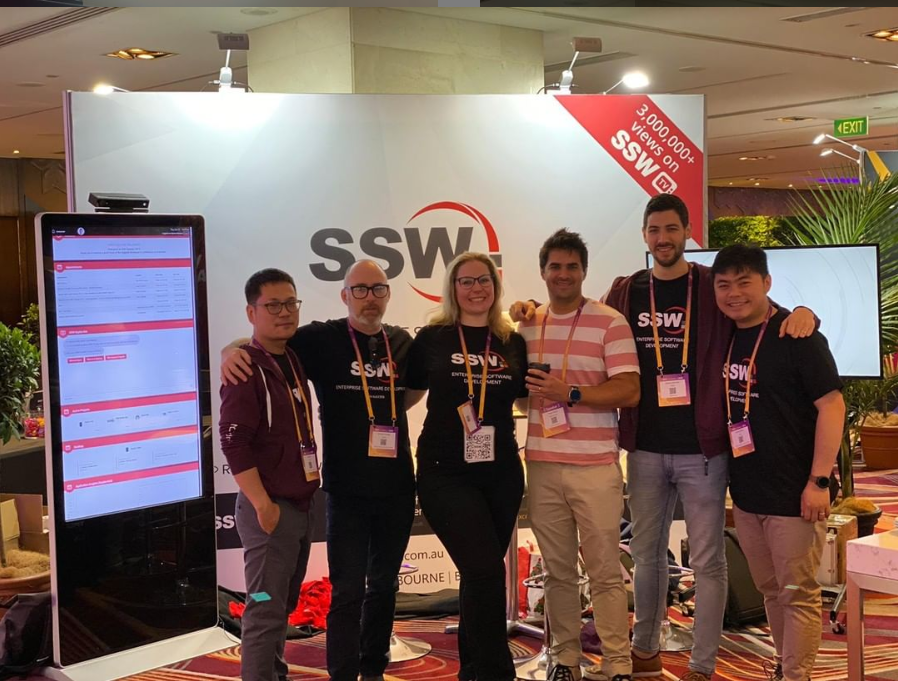
✅ Figure: Good Example - Part of the SSW team attending NDC Sydney 2019 wearing special shirts we created for this event + branded backdrop for our booth
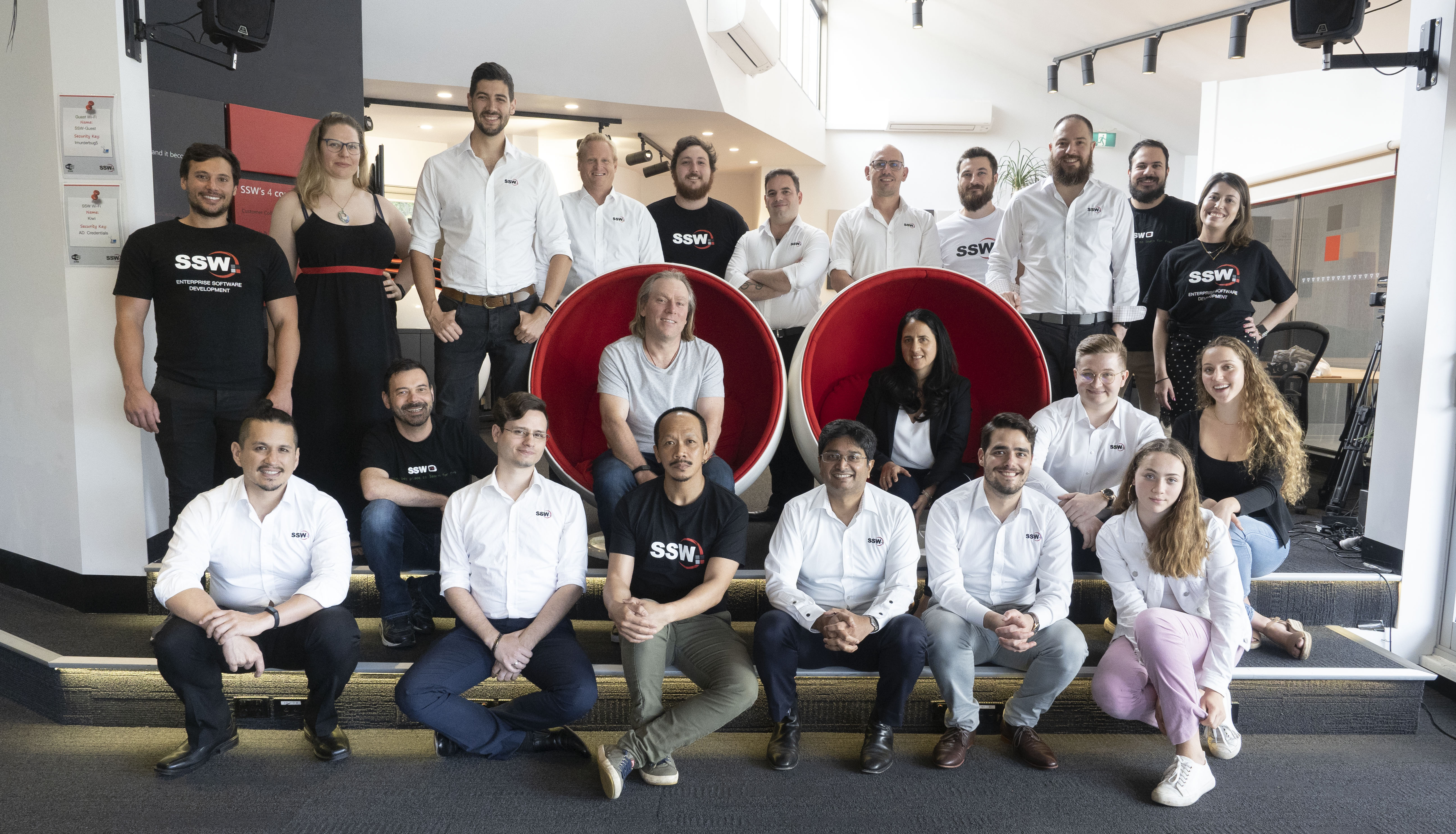
✅ Figure: Good Example - Some of our Sydney team wearing different branded shirts
Of course, another great way of promoting your company via your staff is on their social media accounts. You can encourage your staff to update their social media bio's to include their role and the company they work for, plus the website if there are enough characters for it. Wherever your employees gather in large numbers, ensure they come branded.
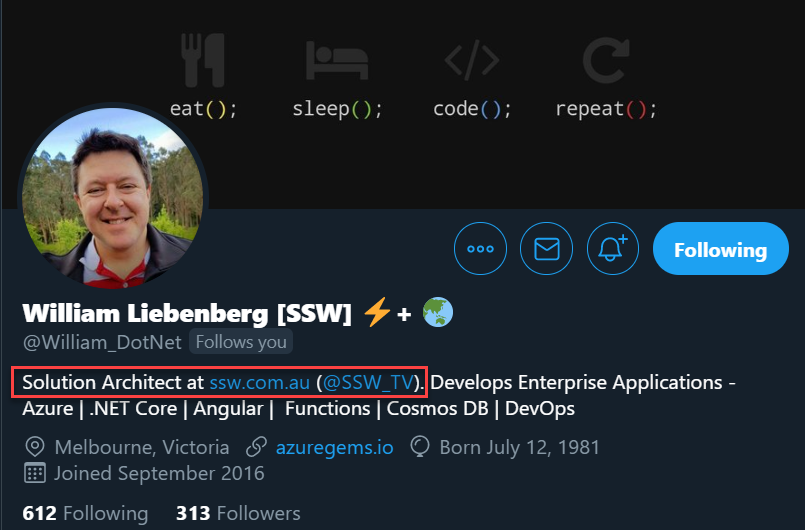
✅ Figure: Good Example - Your employee profile on social media can also be branded
Do you include the company name when referring to your job title?
<introEmbed body={<> Consistency is the most important part of branding. It leads to familiarity which builds brand recognition. A simple and effective method is prefixing job titles everywhere they appear with the company name. </>} /> A job title on social media or other public place should **always** be: * **{{ COMPANY NAME }} {{ POSITION }}** E.g. "SSW Software Engineer" <asideEmbed variant="info" body={<> On LinkedIn you might put your title in 2 places (bio and job experience) **In both places, you should use the correct format!** </>} figureEmbed={{ preset: "default", figure: 'XXX', shouldDisplay: false }} /> This is to maintain consistency across the company - the companies with strong branding have [consistency](https://blog.hubspot.com/blog/tabid/6307/bid/34231/8-businesses-that-nail-social-media-brand-consistency.aspx)! <imageEmbed alt="Image" size="large" showBorder={false} figureEmbed={{ preset: "badExample", figure: 'Bad example - Job title missing the company name', shouldDisplay: true }} src="/uploads/rules/prefix-job-title/job-title-bad.jpg" /> <imageEmbed alt="Image" size="large" showBorder={false} figureEmbed={{ preset: "goodExample", figure: 'Good example - Job title includes the company name and matches other employees', shouldDisplay: true }} src="/uploads/rules/prefix-job-title/job-title-good.jpg" /> <asideEmbed variant="info" body={<> **Note:** Check out a cool way to use ChatGPT to extract profile info from all the users in your organization: <https://x.com/sethhdaily/status/1747460874544324917?s=20> Following the above tweet, you can get a result like this: <figureEmbed figureEmbed={{ preset: "goodExample", figure: '<imageEmbed alt="Image" size="large" showBorder={false} figureEmbed={{ preset: "default", figure: \'Good example - See how much branding is on people\\'s GitHub profiles\', shouldDisplay: true }} src="/uploads/rules/prefix-job-title/excel-result.png" /> </>} figureEmbed={{ preset: "default", figure: \'XXX\', shouldDisplay: false }} />', shouldDisplay: true } } />Do you use a consistent phone message?
<introEmbed body={<> You should remember that any point of contact leaves an impression on clients or customers so, as a consultant, even the answering service on your phone should be taken into consideration. Your personal mobile phone should have a standard answering message for any missed calls. While many people don't use voice mail now, it's still nice to include subtle SSW branding in your message (noting that choosing to do so is entirely your choice). </>} />✅ Reinforces a professional image when clients call you
✅ A quick, subtle and easy way to promote the SSW brand
✅ Free!
❌ May not be appropriate for some employees (e.g. part-timers and/or those with other business interests)
❌ Voice mail is often just a black hole that's rarely checked"Hi, you've reached Cameron Shaw from SSW. If you could leave your name, number and a short message I'll get back to you as soon as I can. Thanks!"
❌ Figure: Bad example (and [how it sounds](https://www.ssw.com.au/ssw/Standards/Rules/sounds/PhoneMessage.wav))
"Hi, you've reached Adam Cogan from SSW. I don't use voice mail, so please send an SMS. Thanks!"
✅ Figure: Good example (and [how it sounds](https://github.com/SSWConsulting/SSW.Rules.Content/blob/main/rules/consistent-phone-message/adam_cogan_answering_message.m4a?raw=true))
Do you brand your (computer safe) coffee mugs and water bottles?
<introEmbed body={<> How often are you sitting at your desk typing away and having an open cup of tea or coffee or glass of water sitting right next to your computer? Do you know how much liquid it takes to kill your computer? The answer is not much; some of our developers found this out the hard way and on more than one occasion. There is an alternative, though, which if in the event spillages occur, limits the amount of liquid being released. Travel safety mugs and sports water bottles are a great way of protecting your computer from unwanted damage from spillage. They also make a fantastic gift to clients, which is an opportunity for you to have a constant reminder of your business in their face and their clients. </>} />Give your clients branded keep cups and sports water bottles as a way of saying thanks to our clients for engaging our services. We also use them for ourselves in the office to protect our own computers. The minimal outlay for these items can literally save you thousands and could potentially start earning you money too.
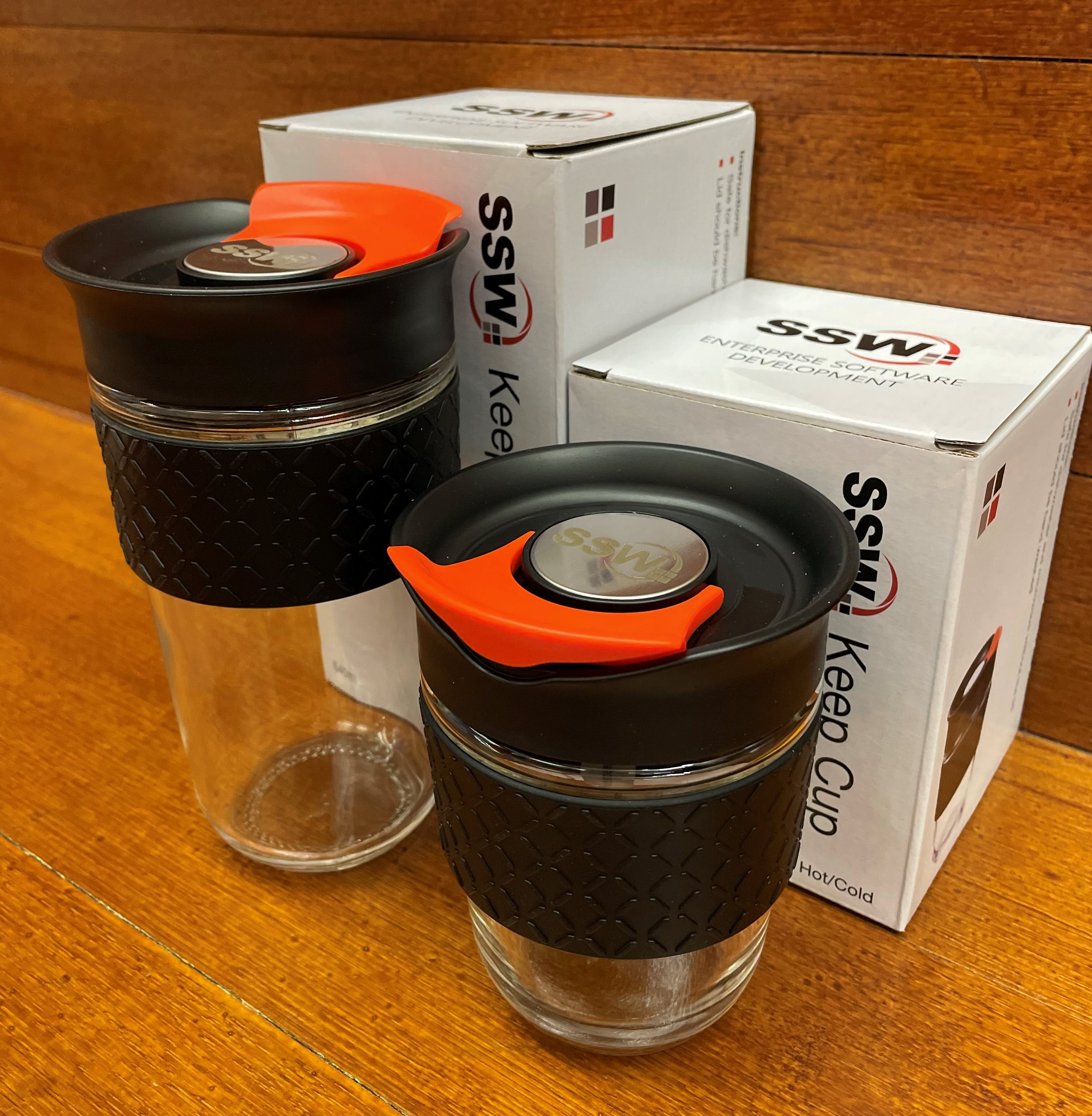
✅ Figure: Good example - Branded keepcups with branded boxes
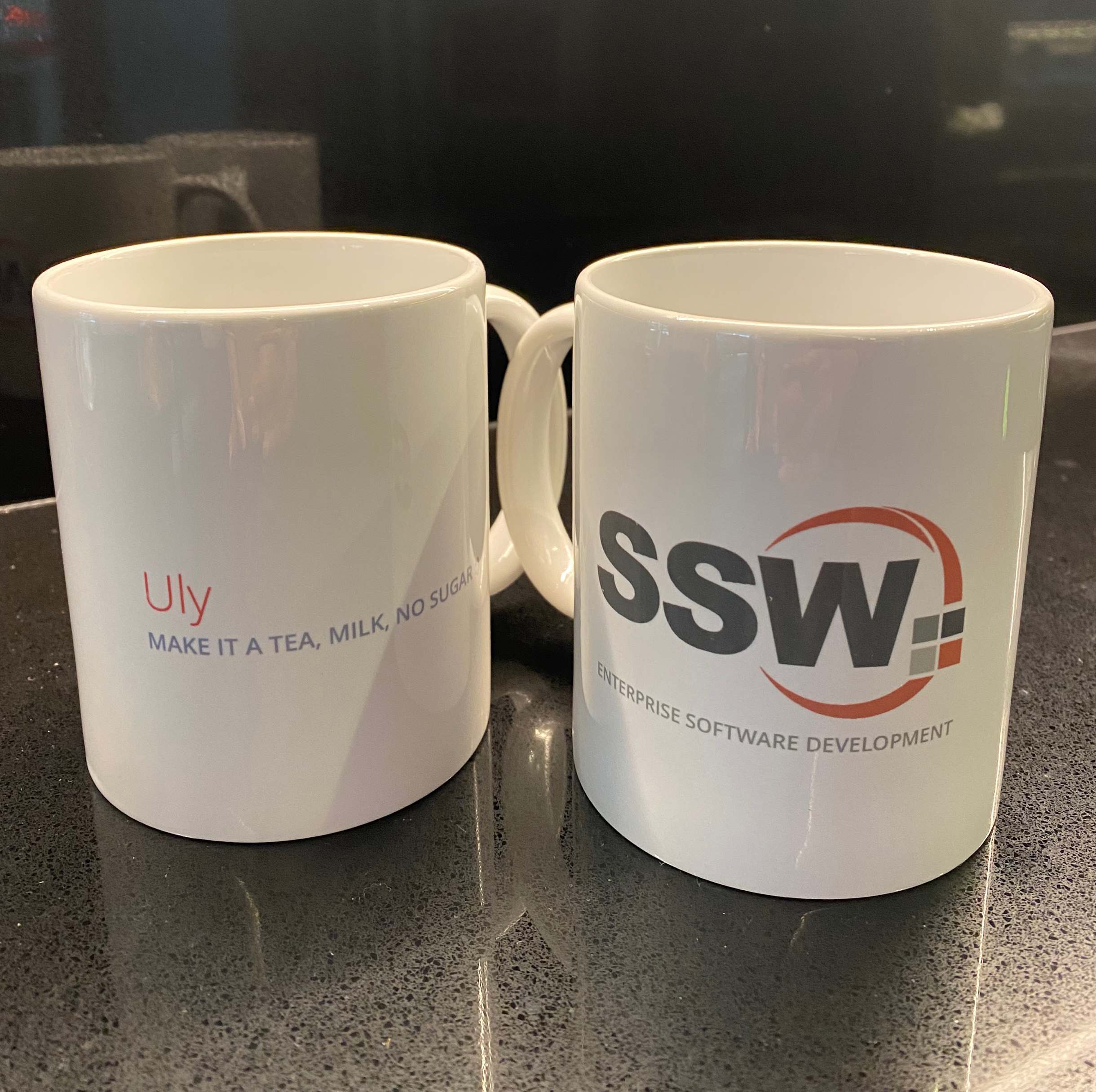
✅ Figure: Good example - Branded mugs for your team to use when they are in the office ☕
Do you brand your assets?
<introEmbed body={<> You should take every chance you get to put your logo on things. Branding your assets is one more thing that you can do to spread your brand to the world. </>} />For example, if you provide your team with laptops, those laptops should be branded with your logo, so they can be seen when they visit a client. This is especially important when assets already have another brand on them - we don't want to be promoting someone else when we could be promoting ourselves.
You should enforce this for any asset that is owned by your business, like when it was purchased via salary sacrifice.
- Brand important items, like laptops, with a custom skin
- If you can't have a custom skin, use a sticker
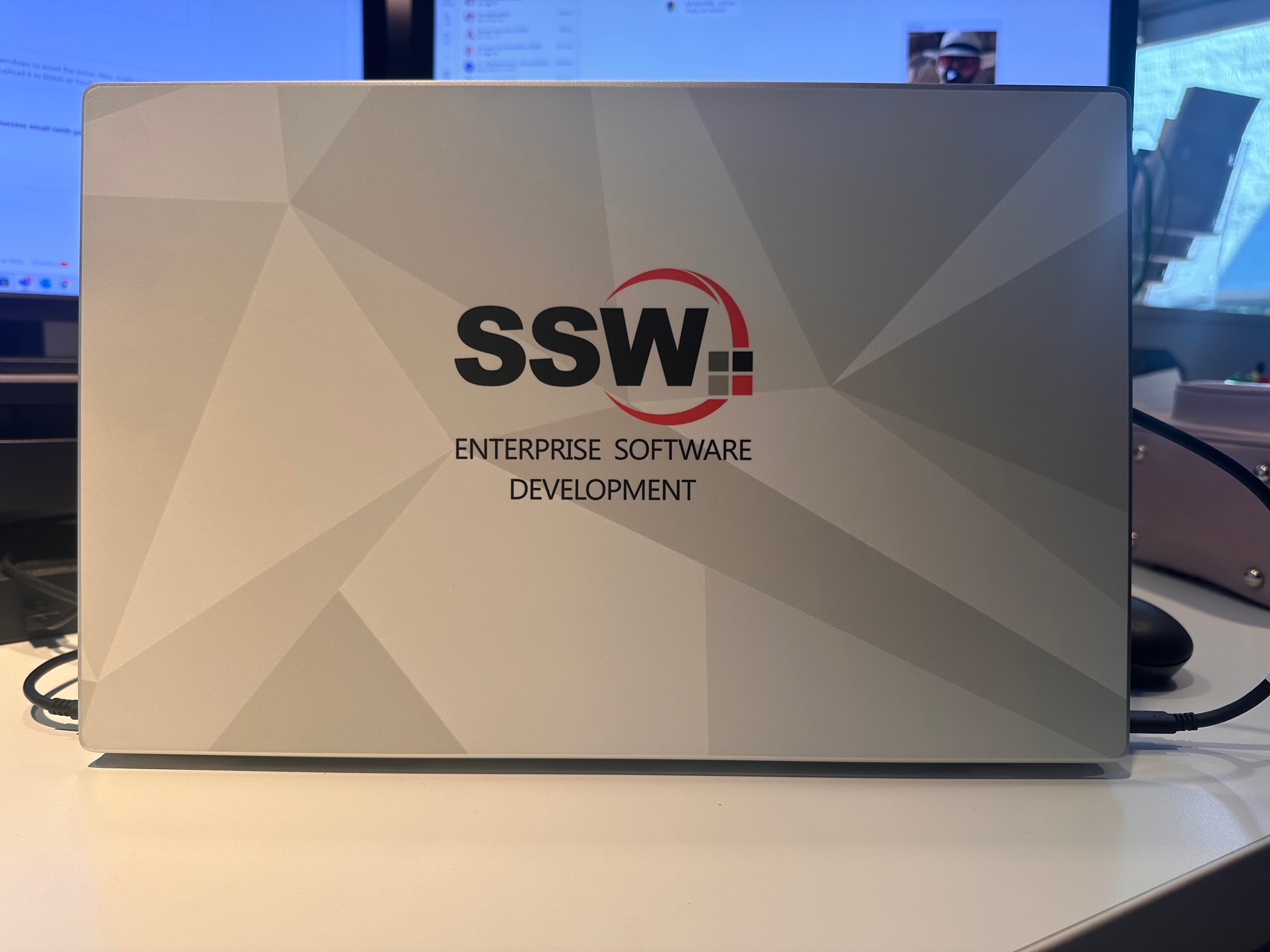
Figure: Custom laptop skin - take every chance to show off your brand
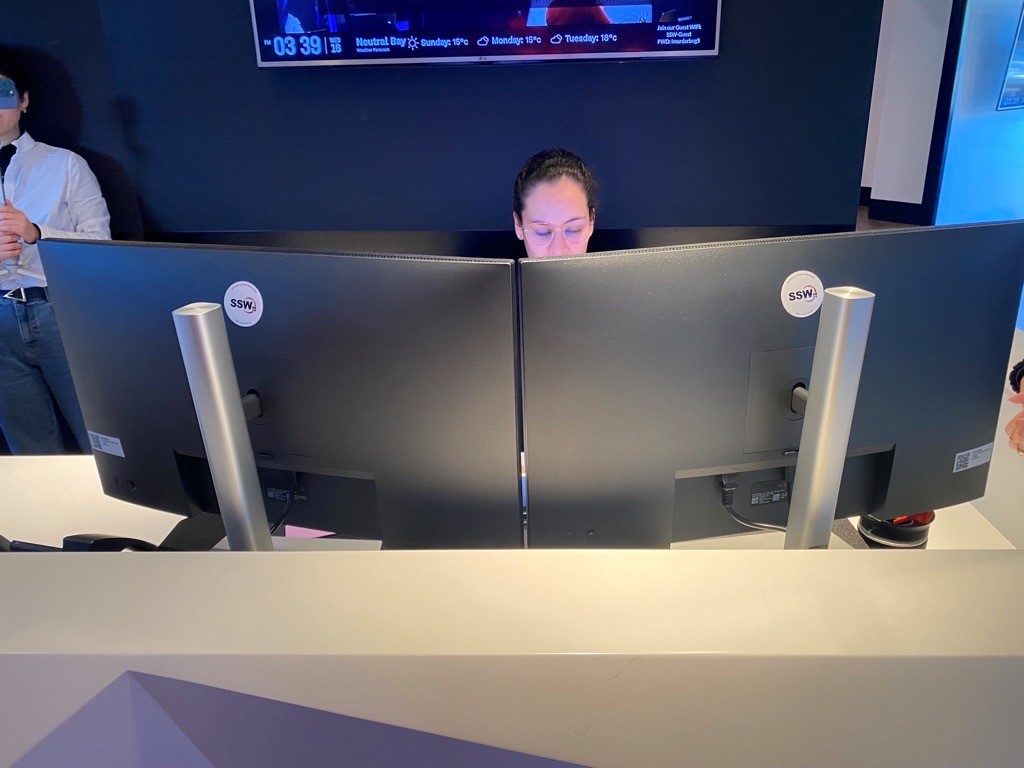
Figure: We don't need to be promoting Dell - use a branded sticker to cover it up!
Tip: For items like laptops, it's also a good idea to tape your business card underneath so it can be returned to you if you lose it.
Do you make your presents branded?
<introEmbed body={<> If you get a physical gift (e.g. wine bottle or a hamper), you can add stickers on the gifts for better branding. In case you go for a virtual gift, e.g. An e-voucher (usually sent via email), you can also add your logo to it. </>} />Tip: Remember to make your gift extra special! You should personalize it by purchasing something for your client related to a hobby, for example.
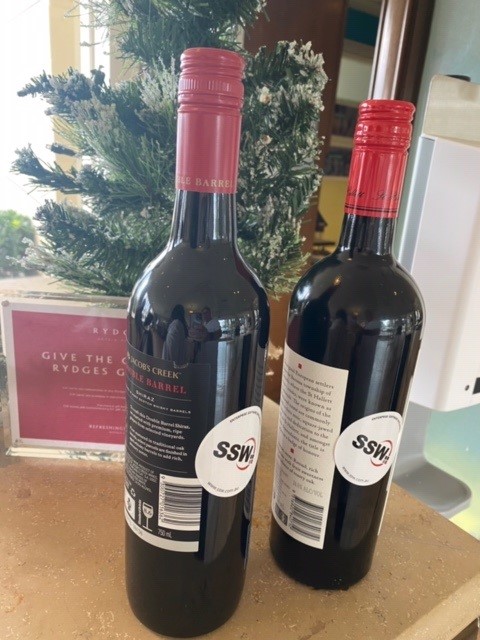
Figure: stickers added to wine bottles as a Christmas present for clients
Do you brand your takeaway coffee cups?
<introEmbed body={<> Using branded stickers on coffee cups is a great way to promote your brand at events, conferences, training seminars and other functions. It is a cost-effective way to make a lasting impression about your brand. </>} />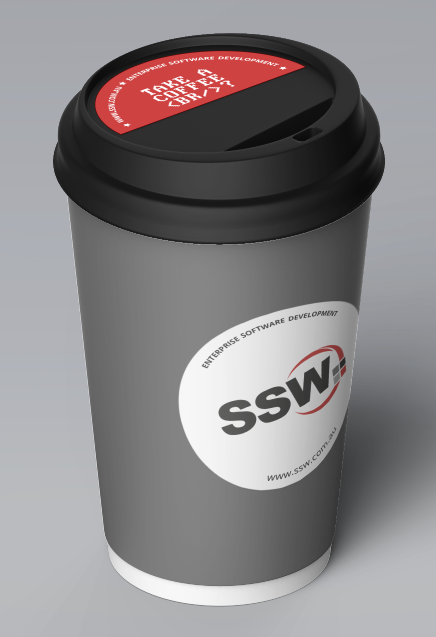
Figure: SSW Take Away Coffee Cup
LinkedIn - Do you have links to your main services on your profile?
<introEmbed body={<> LinkedIn is the main business and employment-oriented social networking service available. It's important to keep it up-to-date and link it to your company's services. </>} />A featured section will allow you to highlight services in your profile. To achieve that, follow the instructions from LinkedIn: Add Sections to Your Profile | LinkedIn Help.
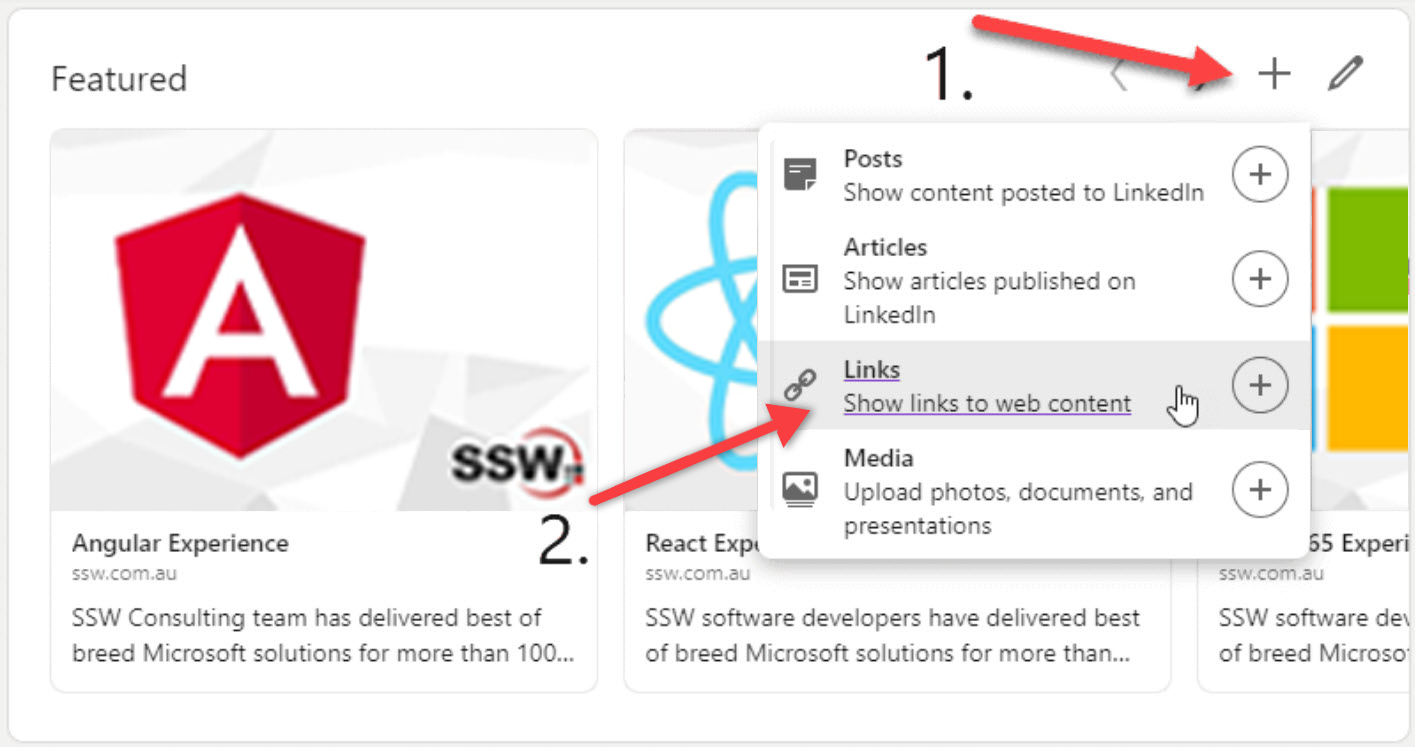
Figure: In the Featured section, use the "+" and then "Links" buttons to include the URLs for the main services your provide
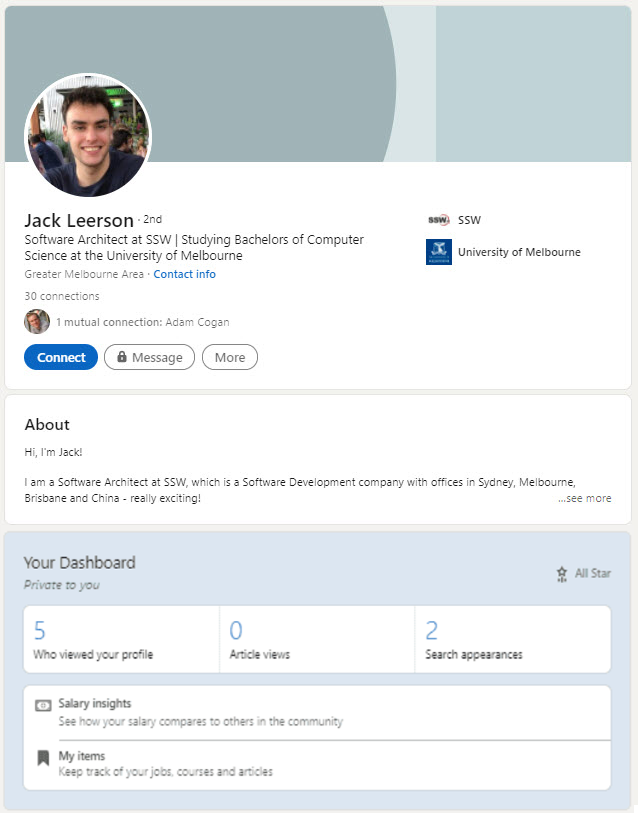
❌ Figure: Bad example - Profile with no links
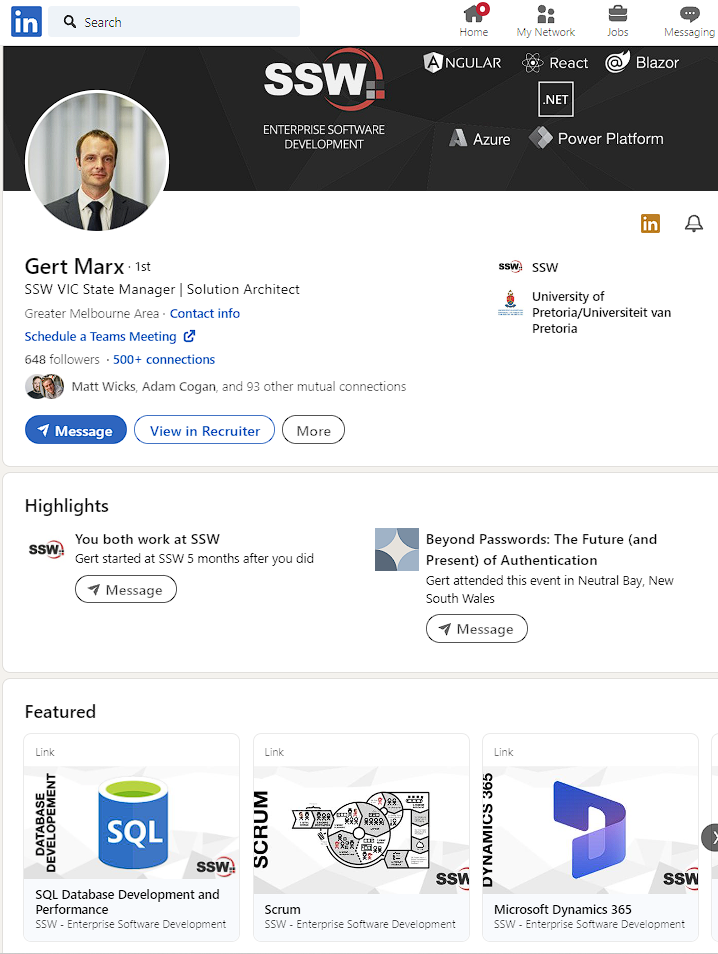
✅ Figure: Good example - Profile with links to main services provided
Do you add branding to screenshots?
<introEmbed body={<> It is great when people use screenshots. You can communicate better by using screenshots with balloons and other visual elements (arrows, shapes, and highlights) instead of only text. [Read the benefits of using screenshots](/screenshots-avoid-walls-of-text). </>} />We recommend you define a standard style for your visual elements by changing the default colors and shapes according to your branding.
See some examples of different visual elements under same branding:
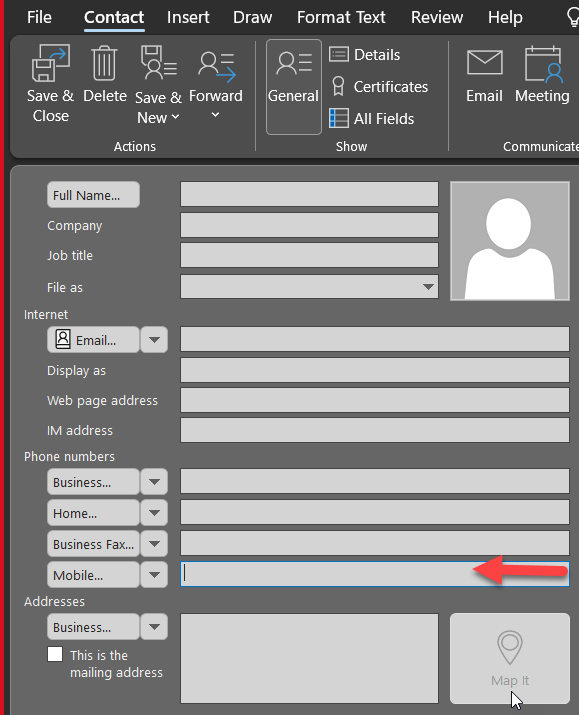
Figure: Indicate someone to enter the mobile field. Do you use a red arrow?
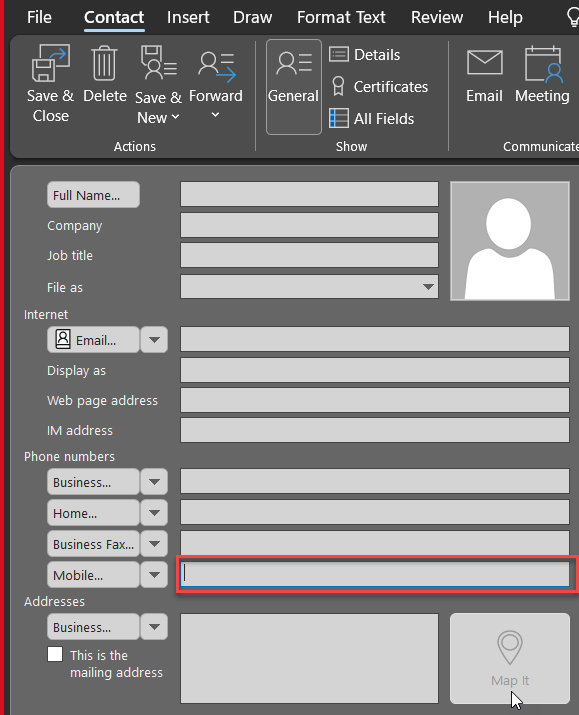
Figure: Or do you like the red box?
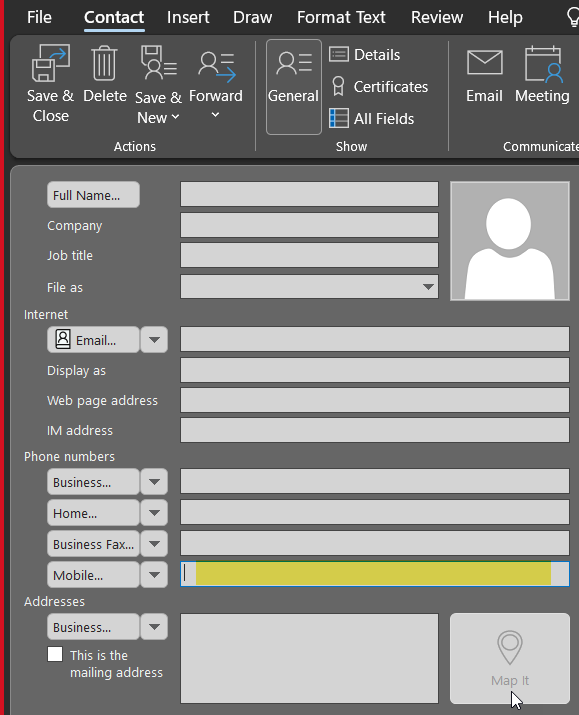
Figure: Or do you like the yellow highlight?
More Information on SSW Branding
You can automatically have the SSW Snagit presets on sign-in via a script.
Instructions to create and use Snagit themes can be found at Quick Style Themes Tutorial.
Do you brand your plastic bags?
<introEmbed body={<> Branded Plastic Bags should be used for giveaways, and people within the office who want an extra bag to carry things to client site or home. This provides free marketing especially when the employee catches public transport home. It is a win-win as the person gets free carry bag, and we get free marketing. </>} />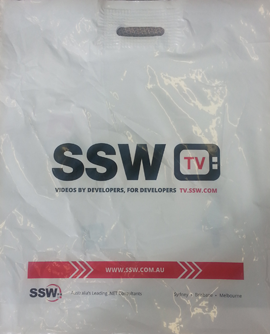
Figure: SSW plastic bag